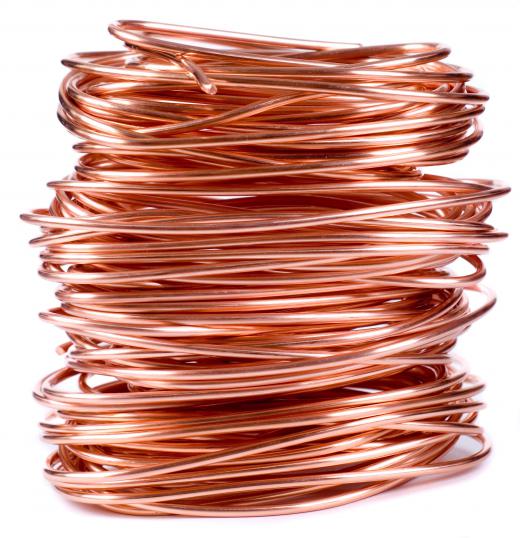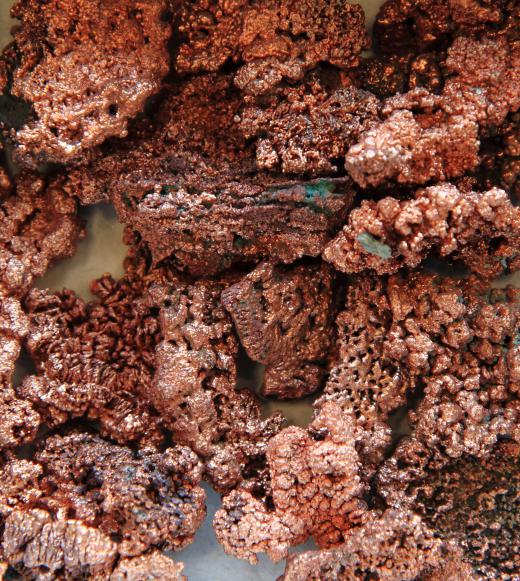What is Bioleaching?
Bioleaching is the use of bacterial microorganisms to extract precious metals, such as gold, from ore in which it is embedded. As an alternative to smelting or roasting, miners use bioleaching when there are lower concentrations of metal in ore and they need an efficient, environmentally responsible method to extract it. The bacteria feeds on nutrients in minerals, thereby separating the metal from the ore. Other metals that are commonly extracted via bioleaching include silver, zinc, copper, lead and uranium.
Uses Special Microorganisms

This process works because of how special microorganisms act on mineral deposits. These microorganisms are catalysts to speed up natural processes in the ore. The types of bacteria most often used in this process include Leptospirillum ferrooxidans, Thiobacillus ferrooxidans and certain species of Acidianus, Sulfolobus and Sulfobacillus.
Oxidation
The bacteria use a chemical reaction called oxidation to turn metal sulphide crystals into sulfates and pure metals. These constituent parts of ore are separated into valuable metal and leftover sulphur and other acidic chemicals. Eventually, enough material builds up in the waste solution to filter and concentrate it into recoverable metal.
Feasibility

For some types of metal, such as copper, bioleaching is not always economically feasible or fast enough, even with its low cost. In certain areas of the world or with other metals, however, this simple, effective and low-cost method is considered to be a smart choice. For example, developing countries often do not have the infrastructure or capital investment to begin smelting, but their land contains enough ore that its extraction can significantly improve their national economies. Many scientists believe that bioleaching might someday be used to mine metals such as zinc and nickel on the moon.
Low Impact on the Environment
As of the early 21st century, about 20% of the extracted copper in the world came from bioleaching. Mining companies must be careful of pollution that might result from solutions reaching a groundwater source. Overall, however, bioleaching produces a relatively small amount of air pollution and little damage to geological formations, because the bacteria occurs there naturally. An ideal metal deposit must allow a certain amount of water into the rock to carry the bacteria. It should be surrounded by rock that is impermeable to water, however, to make sure that no groundwater gets polluted with sulphur.
AS FEATURED ON:
AS FEATURED ON:












Discussion Comments
I wanted to know about bioleaching in copper.
I am from Karnataka India and in process of setting plant for bio leaching gold ores is 100 TPD. I have already acquired four acres of industrial land and am in the process for clearance for pollution and environment.
I want to know about the process of bioleaching in copper.
How long does the process of bioleaching take?
I'm doing some work about Bioleaching of Copper and just need a few more points. Could you give me some please? Just a couple?
How strange your name is also Avinesh. Me too. The bacteria that is not in soil will not kill bacteria in soil?
I want to ask, are not the bacteria poisoned by the poisonous Sulphite produced? please reply soon. thank you.
i want to know how to carry out bioleaching of copper (malachite) in a laboratory as a project work.
also the experimental setup and the requirements.
could you explain what the bacteria actually do - do they eat the copper, or eject chemicals before they devour it, or what?
I am Ladu from Ain Shams (Egypt). I would like to know how bioleaching can be applied especially in a country with technology like Sudan. Thanks for responding.
i need some good references for an assignment on bioleaching. please let me know the details. thank you.
Please send me all the info regarding bioleaching and biometallurgy.
i would like to know more about the process of bioleaching.
for sonali. The Indian labs of CSIR namely NML and IMMT are working lots in this area.
anon31883:
not all bacteria can do this but Acidithiobacillus ferrooxidans can as well as fungi including Aspergillus niger.
Are all the microorganisms including cyanobacteria capable of bioleaching? Is the process feasible? How is the process operating?
I am sonali from Orissa (India) I want know the recent work status of bioleaching.
anon9689 - It is not given that bioleaching can be used on the Moon. It is given that bioleaching _may_ be used on the Moon, in the future. Although man has been to the moon, he does not know the moon entirely. There _may_ be so many micro-organisms that we are not aware of on the Moon itself (thriving in vacuum conditions, freezing cold temperatures)...what about aliens themselves?
dear sir, You have mentioned that we can use bioleaching to extract metals from moon surface. And the doubt is ; is their any microbe found on moon? If yes what is the nature of them?
I am avinash from HYDERABAD (INDIA).
i want to know about the process of bioleaching in which how it differs from normal chemical process.
thank you.
Post your comments